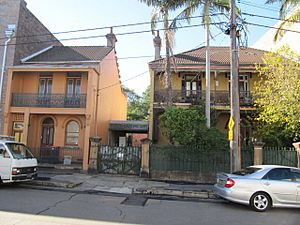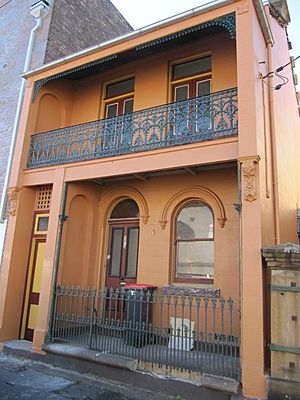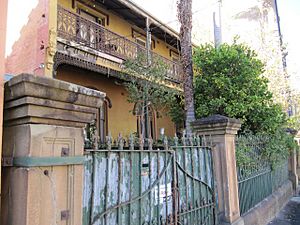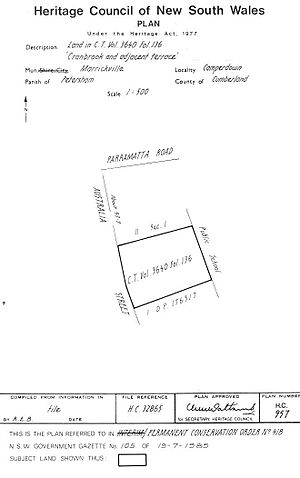Cranbrook, Camperdown facts for kids
Quick facts for kids Cranbrook |
|
|---|---|

No 10 and 14 Australia Street
|
|
| Location | 10 & 14 Australia Street, Camperdown, Inner West Council, New South Wales, Australia |
| Built | 1879–1881 |
| Official name: Cranbrook Group; Fowlers House | |
| Type | state heritage (built) |
| Designated | 2 April 1999 |
| Reference no. | 418 |
| Type | Villa |
| Category | Residential buildings (private) |
| Lua error in Module:Location_map at line 420: attempt to index field 'wikibase' (a nil value). | |
Cranbrook is a special old house located at 14 Australia Street in Camperdown, Australia. It was built a long time ago, between 1879 and 1881. This house is also known as Fowlers House. It's so important that it was added to the New South Wales State Heritage Register on April 2, 1999. This means it's a protected historical site.
Contents
The Story of Cranbrook
Who Built Cranbrook?
Cranbrook was finished in 1881 by a man named Robert Fowler. Robert was a very important person in his time. He took over a successful pottery business from his father in 1879. This business made things like pipes and tiles.
Robert was also a leader in his community. He was the mayor of several towns, including Camperdown and the City of Sydney. He even served as a politician in the New South Wales Legislative Assembly and later in the New South Wales Legislative Council.
What Cranbrook Was Like
Cranbrook was a grand house with beautiful gardens. It had special areas for ferns and even an orchard. Today, where the orchard used to be, you'll find the Camperdown Oval. A bathroom was added to the house in the 1890s.
Robert's brother, John, built the house right next door at No. 10 Australia Street. This house might have been for servants or managers. It was connected to Cranbrook by a shared driveway and courtyard.
Changes Over Time
Robert Fowler lived in Cranbrook until he passed away on June 12, 1906. His wife, Susannah, continued to live there after he died.
In 1919, Cranbrook was sold to Charles Daintree. The garden part of Cranbrook was bought by the Department of Education. It was then added to the Camperdown Public School.
A few years later, in 1924, a strip of land from the house was taken. This land, where the ballroom and orchard once stood, was used for a company that made electricity meters.
By 1981, the two houses, No. 10 and No. 14, were owned by the Brown family. They rented out rooms in the houses. At this time, the local council, Marrickville Council, worked to protect the buildings from being harmed or torn down. They got special orders to keep the houses safe in 1982 and 1984.
In 1982, a new owner named Garry Nicholls bought the property. In 1985, he wanted to restore both houses. He successfully had them listed as a "Permanent Conservation Order" on July 19, 1985. This helped make sure these historic homes would be preserved.
What Cranbrook Looks Like
No. 10 Australia Street
This house is a two-bedroom home built in a terrace style. It has round-shaped doors and windows on the lower floor. These windows have decorative arches around them. On the upper floor, there's another door and a cast iron fence. The roof is made of iron tiles. Many details of this house match the grander Cranbrook house next door.
No. 14 Australia Street (Cranbrook)
Cranbrook is a large, two-storey house with five bedrooms. It's built in an Italianate style, which means it looks like old Italian buildings. It has a small room for boxes and courtyards at the back. The house still has its original cast-iron fence and verandas. The verandas have fancy tooth-like decorations. There are also large, decorated chimneys and outside steps. These steps have marble hand-rails and sandstone balusters (small pillars). Inside, you can see beautiful marble fireplaces and colorful etched glass. The staircase is also very detailed and carved.
Why Cranbrook is Important
The Cranbrook Group, which includes both No. 10 and No. 14, is very important to the history of New South Wales. It's one of the last parts of the huge Fowler family estate, which used to cover most of Camperdown.
This place is connected to Enoch Fowler and was the home of Robert Fowler. Robert was not only the owner of the Fowler Pottery business but also a Lord Mayor of Sydney and Camperdown. The Fowler family were pioneers in the pottery industry in New South Wales. They made many useful items like pipes, tiles, and chimney pots.
The houses are also important because they still have most of their original Italianate design features. This makes them beautiful examples of architecture from that time.
Cranbrook was officially listed on the New South Wales State Heritage Register on April 2, 1999. This listing helps protect it for future generations.




